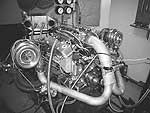
The one thing that can be said for Butler Performance Group is that the company is not one to rest on its laurels. In addition to building a 440ci, 2,200hp, gasoline-burning twin-turbo Pontiac V-8, building a pump-gas 467 to compete in the PHR Engine Masters Challenge, as well as developing reproduction Ram Air IV heads and intake and a new extreme-duty aluminum V-8 block, they have also built up the world's most powerful traditional Pontiac V-8 yet assembled. "Wait-a-minute," you may say, "didn't the company already do that?"
Actually, their 2,200-plus-hp V-8 held that title for a while, but it too has been eclipsed by this latest project. This new engine is a part of the aluminum block program and was built to test the outer limits of the new casting's strength. "We decided to build this engine and just crank up the boost until something broke," said Rodney Butler. "From there, we could see where the block would need reinforcing and then could make the necessary changes to the molds."
The funny thing is, that moment has yet to occur. Even after repeated dyno thrashes and a level of power that is so high that it actually caused boiling in the water brake, the Butler block held up, with none of the typical problems, such as main cap walk, head sealing problems, or the infamous longitudinal block splitting, so common with high-horse applications using a production block. In fact, the bottom end looks so good that Rodney said he doesn't even need to change the rings or bearings.
So just how high a horsepower level are we talking here? Thought you'd never ask. With a 4.25-inch bore and stroke making for a displacement of 482 ci, the new V-8 uses wide-port Edelbrock heads, a pair of Turbonetics 91mm ceramic ball bearing turbos, and an EFI system that has been dubbed "The Starship Enterprise," Rodney Butler and his partner Travis Quillen have pulled a staggering 2,886 hp at 7,200 rpm, with 2,105 lb-ft of torque at the same level. The torque curve was equally astounding, with over 1,900 lb-ft available up to 7,600 rpm. The horsepower stayed above 2,700 up through 7,800 rpm. Travis added that, "We would have liked to pull the engine a bit lower, but the dyno simply would not hold this kind of torque. I would imagine that torque at 6,500 rpm would be in excess of 2,250 lb-ft, but of course we have no real way of knowing for sure."
Why make the change from gasoline to alcohol with this application? There are several reasons. Travis Quillen said, "Many racers use alcohol for fuel in order to gain horsepower; we chose to use alcohol for the potential weight savings and reduction in system complexity. The cooling effect of alcohol vaporization negates the need for an intercooler, which saves approximately 125 pounds of water tank, pump, lines, etc., and also reduces the amount of cooling system necessary (radiator, water pump, etc). Also, the reduction/elimination of these components adds reliability and reduces the amount of maintenance required between rounds.
"There are definitely some differences in the tune-up of this motor compared to the old motor. The biggest one revolves around using alcohol for fuel instead of gasoline. Common theory says that it takes about twice as much alcohol as gasoline for the same horsepower; we found that this engine liked even more fuel than that. Another big difference was in ignition timing and compression ratio; we raised the compression ratio by about 2 full points and also used about 4 degrees more ignition timing at the same boost pressure with this engine versus the gasoline engine.
"Tuning on the dyno was fairly similar to tuning any other turbocharged engine, except that we did not use the wide-band oxygen sensor in the same manner that we usually do. We tuned mainly from spark plug readings, similar to blown alcohol applications. From the looks of the spark plugs and rod bearings, we can say that even at 2,886 hp we have a very safe tune on the engine right now. This engine should be capable of well over 3,000 hp and around 2,300 lb-ft when we 'lean on it' with the new car."
After a dozen dyno pulls, Rodney tore the engine down to inspect the componentry and evaluate what might be improved. Surprisingly, the long-block is not nearly as exotic as the power levels would indicate. The same can't be said for the induction system, however. Follow along as we show you just what goes into a 2,886hp traditional Pontiac V-8. We'll present this information from top to bottom, beginning with the induction.
General Engine Specifications
Dyno Data
Due to the fact that the engine was actually overpowering the dyno, the pulls were only recorded from 7,200 to 7,800 rpm. The torque was too high to record below the minimum rpm figure listed.